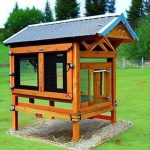Keeping chickens warm in winter is essential for their health and well-being. As the temperatures drop, chickens are at risk of suffering from cold stress, which can lead to a variety of health issues and even death. Providing warmth for chickens is crucial to ensure that they stay comfortable and healthy throughout the winter months.
Key Takeaways
- Chickens need warmth to maintain their body temperature and stay healthy in winter.
- Factors affecting the warmth of the chicken coop include insulation, bedding material, ventilation, and heat sources.
- Choosing the right bedding material, such as straw or wood shavings, can help keep chickens warm and dry.
- Insulating the chicken coop with materials like foam board or bubble wrap can help retain heat.
- Monitoring temperature and humidity levels with a thermometer and hygrometer can ensure the coop stays at a comfortable level for chickens.
Why do chickens need warmth?
Chickens need warmth, especially during winter, because they are not able to regulate their body temperature as efficiently as mammals. Unlike humans and other warm-blooded animals, chickens do not have sweat glands to cool themselves down in hot weather or shiver to generate heat in cold weather. Instead, they rely on their feathers and body fat to keep warm.
Exposing chickens to cold temperatures can have serious consequences. Cold stress can weaken their immune system, making them more susceptible to diseases. It can also lead to frostbite, respiratory issues, and even death. It is important to provide a warm and comfortable environment for chickens to prevent these problems.
Factors affecting the warmth of the chicken coop
Several factors can affect the warmth of the chicken coop, including its location, size, and construction materials. The location of the coop plays a significant role in its ability to retain heat. Placing the coop in a sheltered area away from strong winds and direct sunlight can help maintain a more stable temperature inside.
The size of the coop also affects its warmth. A smaller coop will be easier to heat than a larger one because there is less space for heat to escape. However, it is important to ensure that the coop is not overcrowded, as this can lead to poor air quality and increased humidity levels.
The construction materials used for the coop can also impact its warmth. Insulating materials such as foam board or straw bales can help retain heat inside the coop. Additionally, sealing any gaps or cracks in the walls and windows can prevent drafts and heat loss.
Choosing the right bedding material
Choosing the right bedding material for the chicken coop is crucial for keeping chickens warm in winter. Bedding provides insulation and helps regulate moisture levels inside the coop. There are several types of bedding materials available, each with its own pros and cons.
Straw is a popular choice for chicken coop bedding because it is affordable and readily available. It provides good insulation and absorbs moisture well. However, straw can be messy and may need to be replaced frequently to maintain cleanliness.
Wood shavings are another common bedding material. They are absorbent and provide good insulation. However, they can be more expensive than straw and may need to be replaced more often.
Other options include shredded paper, sand, and pine needles. Each of these materials has its own advantages and disadvantages, so it is important to choose one that suits your needs and preferences.
Insulating the chicken coop
Insulating the chicken coop is an effective way to keep it warm during winter. Insulation helps prevent heat loss and maintains a more stable temperature inside the coop. There are several types of insulation materials that can be used.
Foam board insulation is a popular choice because it is easy to install and provides excellent insulation. It can be cut to fit the walls and ceiling of the coop, creating a barrier against heat loss. However, foam board insulation can be expensive, so it may not be suitable for everyone.
Another option is reflective insulation, which consists of a layer of foil or other reflective material sandwiched between layers of insulation. This type of insulation reflects heat back into the coop, helping to maintain a warmer temperature.
Natural insulation materials such as straw bales or hay can also be used to insulate the coop. These materials provide good insulation and are more affordable than other options. However, they may need to be replaced more frequently as they can become damp and moldy over time.
Providing additional heat sources

In addition to insulation, providing additional heat sources can help keep the chicken coop warm in winter. There are several types of heat sources that can be used, each with its own pros and cons.
Heat lamps are a popular choice because they provide direct heat and can be easily adjusted to the desired temperature. However, they can be a fire hazard if not used properly and can cause burns if they come into contact with chickens or bedding.
Ceramic heat emitters are another option. They emit infrared heat, which is absorbed by the objects in the coop, including the chickens. This type of heat source is safe to use and does not emit light, which can disrupt the chickens’ sleep patterns.
Heated pads or mats can also be used to provide warmth. These pads are placed under the bedding and provide a gentle heat that keeps the coop warm. However, they can be expensive to purchase and may not be suitable for larger coops.
Ventilation and air circulation
Proper ventilation and air circulation are important for maintaining a healthy environment inside the chicken coop. Good ventilation helps remove moisture, ammonia, and other gases that can build up inside the coop and cause respiratory issues. It also helps regulate temperature and prevent condensation.
However, it is important to ensure that ventilation does not compromise the warmth of the coop. Drafts can cause cold spots and increase heat loss. It is important to strike a balance between proper ventilation and maintaining a warm environment.
Preventing drafts in the chicken coop
Drafts in the chicken coop can be detrimental to the health of the chickens. They can cause cold spots, increase heat loss, and make it difficult for chickens to regulate their body temperature. It is important to prevent drafts while still ensuring proper ventilation and air circulation.
Sealing any gaps or cracks in the walls, windows, and doors of the coop is essential for preventing drafts. Weatherstripping or caulking can be used to seal these areas and prevent cold air from entering the coop.
It is also important to ensure that the coop is well-insulated, as insulation helps prevent drafts. Using insulation materials such as foam board or straw bales can help create a barrier against cold air.
Monitoring the temperature and humidity levels
Monitoring the temperature and humidity levels inside the chicken coop is important for ensuring the health and well-being of the chickens. Extreme temperatures and high humidity can be detrimental to their health.
There are several tools and methods available for monitoring these levels. Thermometers can be placed inside the coop to measure the temperature, while hygrometers can be used to measure humidity. There are also digital monitors available that can provide real-time readings of both temperature and humidity.
It is important to regularly check these levels and make any necessary adjustments to ensure that the chickens are comfortable and healthy.
Conclusion and final tips for keeping chickens warm in winter
Keeping chickens warm in winter is essential for their health and well-being. Providing warmth through insulation, bedding, heat sources, proper ventilation, and monitoring temperature and humidity levels can help ensure that chickens stay comfortable and healthy throughout the winter months.
In addition to these measures, there are a few additional tips that can help keep chickens warm in winter. Providing extra bedding during colder months can help insulate the coop and provide additional warmth. Adding a windbreak or sheltered area outside the coop can also help protect chickens from cold winds.
It is also important to regularly check on the chickens during winter to ensure that they are coping with the cold weather. If any signs of cold stress or illness are observed, it is important to take immediate action to address the issue.
By following these tips and providing a warm and comfortable environment for chickens, you can help ensure their health and well-being throughout the winter months.
If you’re looking for tips on how to keep your chickens warm during the colder months, you’ll definitely want to check out this informative article on poultrywizard.com. It provides valuable insights and practical advice on creating a cozy environment for your feathered friends in your garden chicken coop. From insulating the coop to using heat lamps and providing proper bedding, this article covers all the essential steps to ensure your chickens stay warm and comfortable. For more helpful articles on chicken care, be sure to explore their other resources such as maintaining the floor of your chicken coop and whether guinea fowl can live harmoniously with chickens.
FAQs
What temperature range is ideal for chickens?
Chickens are comfortable in temperatures ranging from 50-80°F. However, they can tolerate temperatures as low as 20°F and as high as 90°F.
What are the signs of a cold chicken?
A cold chicken will appear lethargic, huddle together with other chickens, and may have a pale comb and wattles. They may also stop laying eggs.
How can I keep my chickens warm during winter?
You can keep your chickens warm during winter by insulating their coop, using a heat lamp or ceramic heater, providing them with warm bedding, and ensuring they have access to fresh water.
What bedding is best for keeping chickens warm?
Straw, hay, and wood shavings are good bedding options for keeping chickens warm. Avoid using materials that retain moisture, such as newspaper or cardboard.
Can I use a space heater to keep my chickens warm?
It is not recommended to use a space heater in a chicken coop as it can be a fire hazard. Instead, use a heat lamp or ceramic heater specifically designed for use in a coop.
What should I do if my chickens are still cold?
If your chickens are still cold, you can add more insulation to their coop, provide them with additional bedding, or increase the wattage of their heat lamp. If they continue to appear lethargic, consult a veterinarian.
Meet Walter, the feathered-friend fanatic of Florida! Nestled in the sunshine state, Walter struts through life with his feathered companions, clucking his way to happiness. With a coop that’s fancier than a five-star hotel, he’s the Don Juan of the chicken world. When he’s not teaching his hens to do the cha-cha, you’ll find him in a heated debate with his prized rooster, Sir Clucks-a-Lot. Walter’s poultry passion is no yolk; he’s the sunny-side-up guy you never knew you needed in your flock of friends!







